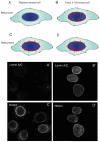Beyond lamins other structural components of the nucleoskeleton
- PMID: 20816232
- PMCID: PMC2936707
- DOI: 10.1016/S0091-679X(10)98005-9
Beyond lamins other structural components of the nucleoskeleton
Abstract
The nucleus is bordered by a double bilayer nuclear envelope, communicates with the cytoplasm via embedded nuclear pore complexes, and is structurally supported by an underlying nucleoskeleton. The nucleoskeleton includes nuclear intermediate filaments formed by lamin proteins, which provide major structural and mechanical support to the nucleus. However, other structural proteins also contribute to the function of the nucleoskeleton and help connect it to the cytoskeleton. This chapter reviews nucleoskeletal components beyond lamins and summarizes specific methods and strategies useful for analyzing nuclear structural proteins including actin, spectrin, titin, linker of nucleoskeleton and cytoskeleton (LINC) complex proteins, and nuclear spindle matrix proteins. These components can localize to highly specific functional subdomains at the nuclear envelope or nuclear interior and can interact either stably or dynamically with a variety of partners. These components confer upon the nucleoskeleton a functional diversity and mechanical resilience that appears to rival the cytoskeleton. To facilitate the exploration of this understudied area of biology, we summarize methods useful for localizing, solubilizing, and immunoprecipitating nuclear structural proteins, and a state-of-the-art method to measure a newly-recognized mechanical property of nucleus.
Copyright (c) 2010 Elsevier Inc. All rights reserved.
Figures




Similar articles
-
Nucleoskeleton proteins for nuclear dynamics.J Biochem. 2021 Apr 18;169(3):237-241. doi: 10.1093/jb/mvab006. J Biochem. 2021. PMID: 33479767
-
Keeping the LINC: the importance of nucleocytoskeletal coupling in intracellular force transmission and cellular function.Biochem Soc Trans. 2011 Dec;39(6):1729-34. doi: 10.1042/BST20110686. Biochem Soc Trans. 2011. PMID: 22103516 Free PMC article. Review.
-
The nucleoskeleton: lamins and actin are major players in essential nuclear functions.Curr Opin Cell Biol. 2003 Jun;15(3):358-66. doi: 10.1016/s0955-0674(03)00050-4. Curr Opin Cell Biol. 2003. PMID: 12787780 Review.
-
LINC complexes in health and disease.Nucleus. 2010 Jan-Feb;1(1):40-52. doi: 10.4161/nucl.1.1.10530. Nucleus. 2010. PMID: 21327104 Free PMC article. Review.
-
Structural insights into LINC complexes.Curr Opin Struct Biol. 2013 Apr;23(2):285-91. doi: 10.1016/j.sbi.2013.03.005. Epub 2013 Apr 15. Curr Opin Struct Biol. 2013. PMID: 23597672 Free PMC article. Review.
Cited by
-
Modeling of Cell Nuclear Mechanics: Classes, Components, and Applications.Cells. 2020 Jul 6;9(7):1623. doi: 10.3390/cells9071623. Cells. 2020. PMID: 32640571 Free PMC article. Review.
-
Molecular Mechanisms for the Regulation of Nuclear Membrane Integrity.Int J Mol Sci. 2023 Oct 23;24(20):15497. doi: 10.3390/ijms242015497. Int J Mol Sci. 2023. PMID: 37895175 Free PMC article. Review.
-
Evolution: functional evolution of nuclear structure.J Cell Biol. 2011 Oct 17;195(2):171-81. doi: 10.1083/jcb.201103171. J Cell Biol. 2011. PMID: 22006947 Free PMC article. Review.
-
Nuclear positioning in muscle development and disease.Front Physiol. 2013 Dec 12;4:363. doi: 10.3389/fphys.2013.00363. Front Physiol. 2013. PMID: 24376424 Free PMC article. Review.
-
The cellular mastermind(?)-mechanotransduction and the nucleus.Prog Mol Biol Transl Sci. 2014;126:157-203. doi: 10.1016/B978-0-12-394624-9.00007-5. Prog Mol Biol Transl Sci. 2014. PMID: 25081618 Free PMC article. Review.
References
-
- Aebi U, Cohn J, Buhle L, Gerace L. The nuclear lamina is a meshwork of intermediate-type filaments. Nature. 1986;323:560–564. - PubMed
-
- Arlucea J, Andrade R, Alonso R, Arechaga J. The nuclear basket of the nuclear pore complex is part of a higher-order filamentous network that is related to chromatin. J. Struct. Biol. 1998;124:51–58. - PubMed
-
- Barboro P, D'Arrigo C, Diaspro A, Mormino M, Alberti I, Parodi S, Patrone E, Balbi C. Unraveling the Organization of the Internal Nuclear Matrix: RNA-Dependent Anchoring of NuMA to a Lamin Scaffold. Experimental Cell Research. 2001;279:202–218. - PubMed
-
- Bennett V, Baines AJ. Spectrin and ankyrin-based pathways: metazoan inventions for integrating cells Into tissues. Physiological Reviews. 2001;81:1353–1392. - PubMed
-
- Bennett V, Gilligan DM. The spectrin-based membrane skeleton and micron-scale organization of the plasma membrane. Annu. Rev. Cell Biol. 1993;9:27–66. - PubMed
Publication types
MeSH terms
Substances
Grants and funding
LinkOut - more resources
Full Text Sources
Other Literature Sources

